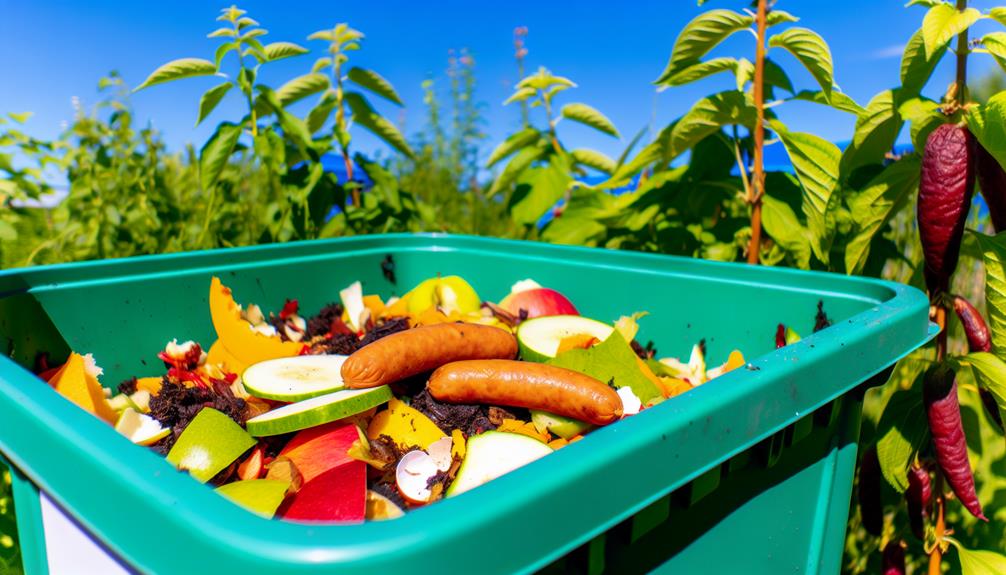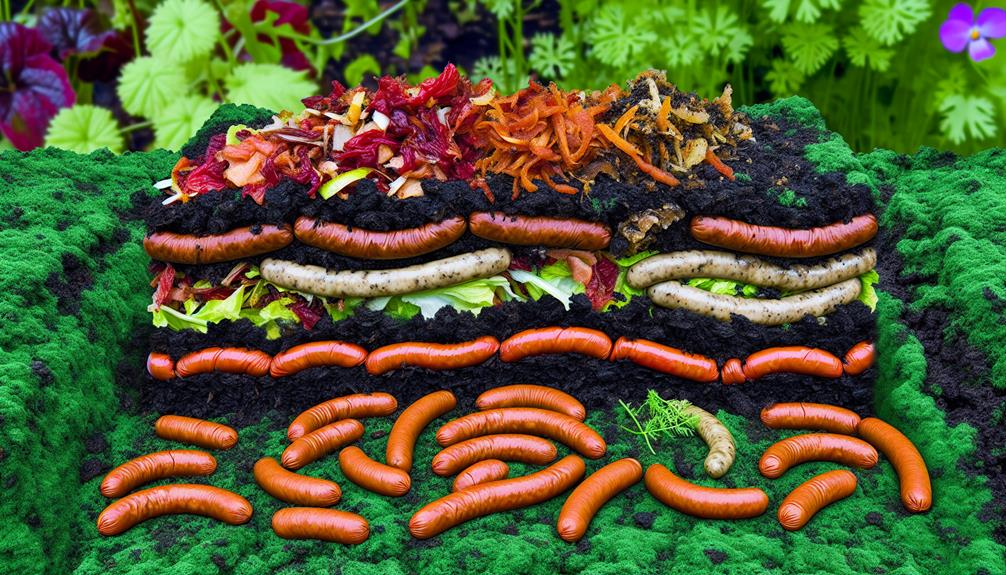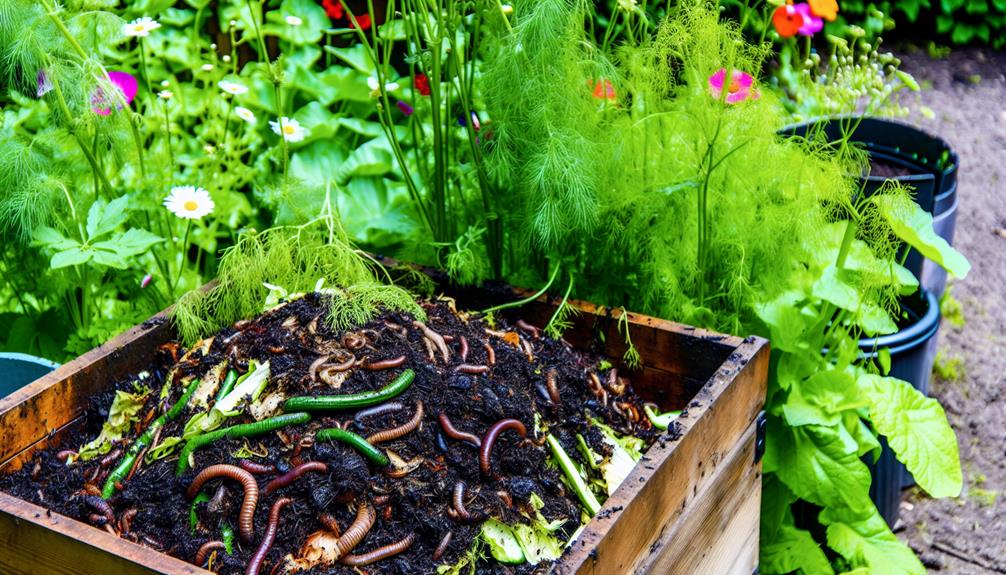

You can compost sausages, but it’s important to manage the process carefully. Meat products like sausages attract pests and can produce strong odors. To mitigate these issues, chop the sausages into small pieces and mix them well with browns, such as leaves or straw, to balance moisture and aeration.
Make sure your compost reaches high temperatures to kill pathogens. Regularly turn your compost pile to reduce the risk of methane gas emissions. If done correctly, composting sausages enriches your soil and reduces landfill waste. There’s a lot more to successful composting, so continue exploring to deepen your understanding.
Before delving into composting sausages, understanding the fundamental principles of composting is crucial. At the heart of it, composting is a natural process that transforms organic materials into nutrient-rich soil. The key to successful composting lies in balancing carbon-rich and nitrogen-rich materials. These are often referred to as browns and greens. Browns include items like dried leaves and cardboard, while greens encompass kitchen scraps and fresh garden waste.
To start, gather your composting materials. Strive for a balanced mix of browns and greens, as this combination fosters efficient decomposition. Keep in mind that smaller pieces break down faster, so chopping larger items can help. Organic recycling through composting reduces landfill waste and enriches your garden soil, creating a sustainable loop.
Moisture and aeration are also critical. Your compost pile should feel like a damp sponge—moist but not waterlogged. Turn the pile regularly to introduce oxygen, which accelerates the breakdown of materials.
Using a compost bin or pile, layer your materials, alternating between browns and greens. This layering technique promotes even decomposition and minimizes odor.
Also Read: Can You Compost Canned Fruits?
When you add meat to your compost, it decomposes and can cause strong odors, which might attract unwanted wildlife pests. Additionally, meat can create an environment that encourages pathogen growth, posing health risks.
It’s important to manage these issues carefully to guarantee safe and effective composting.
When composting sausages, you may want to contemplate balancing your compost with high-carbon materials like dry leaves or cardboard to help manage odor issues. These materials can assist in absorbing moisture and neutralizing odors, enhancing your composting experience.
Moreover, decomposing sausages can impact the nutrient content of your compost. Meat typically serves as a valuable source of nitrogen, crucial for plant growth. However, an excess of nitrogen can disrupt the balance, resulting in an overly damp and smelly compost pile.
Maintaining a healthy compost involves ensuring a good mix of green (nitrogen-rich) and brown (carbon-rich) materials.
Regularly turning your compost can also promote quicker decomposition and improved odor control. By incorporating these practices, you can effectively address the challenges associated with composting sausages and produce a nutrient-rich compost that benefits your garden.
Adding sausages to your compost can attract wildlife pests, making it essential to take preventive measures. Meat, including sausages, is a magnet for wildlife such as rodents and scavengers, who are drawn by the smell and potential food source. This rodent attraction can lead to increased scavenger activity around your compost pile, disrupting your efforts and potentially causing problems in your garden or yard.
To minimize the issues associated with composting sausages, consider the following steps:
Meat in compost, including sausages, can create an environment that fosters pathogen growth. When you add sausages to your compost pile, you risk introducing bacterial contamination. Harmful bacteria, such as Salmonella and E. coli, thrive in decomposing meat. These pathogens can survive in compost piles, especially if the pile doesn’t reach high enough temperatures to kill them, typically over 140°F (60°C).
If your compost pile isn’t managed correctly, these bacteria can spread, leading to disease transmission. This poses a risk, not just to the health of your garden, but also to anyone handling the compost. Even if you’re careful, contaminated compost can transfer pathogens to plants, which may end up in your food.
To avoid these risks, it’s best to keep meat out of your compost. Instead, focus on composting plant-based kitchen scraps, leaves, and grass clippings.
If you still want to compost meat, consider using a specialized composting method, like a Bokashi system, which can handle meat more safely. By taking these precautions, you can maintain a healthy, thriving compost pile without the dangers of bacterial contamination and disease transmission.
Also Read: Can You Compost Candy Wrapper?
By composting sausages, you can effectively reduce food waste and enrich your garden soil with valuable nutrients. When sausages decompose, they contribute to nutrient cycling, a process that returns essential elements back to the soil. This soil enrichment can greatly boost the growth of your plants, making your garden thrive.

Here are four key benefits of composting sausages:
While composting sausages offers numerous benefits, it’s important to consider some potential drawbacks that could impact your composting efforts. One primary concern is the storage requirements for sausages before they make it to your compost pile. Sausages can spoil quickly, and if not stored properly, they could attract pests or create unpleasant odors. You’ll need an airtight container to store them until you’re ready to compost.
Another issue is the disposal methods for sausages. Unlike vegetable scraps, meat products like sausages decompose more slowly and can cause imbalances in your compost. This means you’ll need to pay extra attention to managing your compost pile, turning it more frequently and monitoring its moisture levels.
Additionally, composting sausages could introduce harmful pathogens into your compost, especially if not handled correctly. You should make sure that your compost reaches high enough temperatures to kill any bacteria.
Here’s a quick overview:
| Issue | Description | Solution |
|---|---|---|
| Storage Requirements | Sausages spoil quickly, need airtight containers | Use airtight containers |
| Disposal Methods | Decompose slowly, may imbalance compost | Turn compost frequently |
| Pathogens | Risk of harmful bacteria | Maintain high temps |
Also Read: Can You Compost Candy?
Balancing a compost pile with sausages requires careful attention to the carbon-to-nitrogen ratio to guarantee efficient decomposition. Sausages, like other meat products, are rich in nitrogen. When you add sausages to your compost, you need to balance this high nitrogen content with carbon-rich materials.
Here’s how you can maintain the right balance:
When composting meat like sausages, it’s crucial to follow safe practices to prevent attracting pests and avoid unpleasant odors. Start by incorporating safe handling techniques to minimize contamination. Always wash your hands thoroughly before and after handling meat, and use separate utensils for meat and other compost materials.
Next, focus on proper storage practices. Store sausages in a sealed, airtight container until you’re ready to add them to your compost. This prevents the meat from spoiling and emitting strong odors that attract unwanted pests. Freeze the meat if you’re not immediately using it, as this preserves its integrity and reduces the risk of bacteria growth.
When adding sausages to your compost, make sure you bury them deep within the pile. Covering the meat with a substantial layer of carbon-rich materials like leaves or straw can help mask odors and accelerate decomposition.
Regularly turning your compost pile will also help aerate the mix and distribute the meat evenly, promoting faster breakdown and reducing unpleasant smells.
Also Read: Can You Compost Candle Wax?
When composting sausages, understanding how long they take to decompose is essential. You should consider factors like the breakdown timeframe, environmental impact, and best composting conditions.

In order to comprehend how long it takes for sausages to decompose, you need to take into account several key factors. Decomposition speed hinges on variables like moisture content and temperature control. When you’re composting sausages, here are the main elements to keep in mind:
Composting sausages can greatly impact the environment due to the time they take to decompose and the potential release of greenhouse gases. When you decide to compost sausages, you should be aware that meat products, including sausages, decompose slower than plant-based materials. This extended decomposition period can lead to the emission of methane, a potent greenhouse gas, especially if the composting conditions aren’t ideal.
Understanding the environmental implications is essential. The slow breakdown of sausages means they occupy valuable space in your compost pile for longer periods, potentially leading to resource depletion. This ties into the bigger picture of how sustainable your composting practices are. By delaying the availability of nutrient-rich compost, you might inadvertently contribute to the inefficient use of resources, which affects your garden and the broader ecosystem.
It’s important to manage your compost pile effectively to minimize these adverse effects. By regularly turning your compost and ensuring proper aeration, you can help reduce the release of harmful gases.
To achieve ideal composting conditions for sausages, you must guarantee a balanced mix of greens and browns, along with proper aeration and moisture levels. This balance guarantees efficient decomposition and reduces odors. Greens include nitrogen-rich materials like food scraps, while browns consist of carbon-rich items like dried leaves.
For best results, maintain these optimal conditions:
Under these conditions, sausages can take anywhere from 6 weeks to 6 months to fully decompose. This timeframe varies based on factors like temperature control and the balance of greens and browns.
Also Read: Can You Compost Candle Wax?
Instead of composting sausages, consider donating them to food banks or shelters where they can provide meals for those in need. Many organizations accept non-perishable and frozen foods, including sausages, to help feed individuals and families. Sausage donation not only reduces waste but also supports your community by making sure that valuable food resources are utilized effectively.
If you have pets, another practical alternative is to use sausages as pet food. Make certain that the sausages are suitable for your pet’s diet; consult your veterinarian if you’re unsure. Chop the sausages into small pieces and mix them with your pet’s regular food, being careful to avoid any harmful ingredients like onions or garlic. This method provides your pets with a tasty treat while minimizing food waste.
Moreover, you can always repurpose sausages in your own kitchen. Use them in various recipes like soups, stews, or casseroles. Sausages can be a versatile ingredient that enhances the flavor of many dishes. By exploring these alternatives, you contribute to reducing food waste and supporting your community and pets, creating a sense of belonging and shared responsibility.
To guarantee your compost is healthy, you’ll need to maintain a balanced green-brown ratio and proper moisture levels.

A good mix of green materials like fruit scraps and brown materials like dry leaves supports microbial activity.
Additionally, your compost should feel like a damp sponge, which helps with decomposition.
A balanced green-brown ratio is essential for maintaining a healthy compost pile, ensuring efficient decomposition and nutrient-rich soil. Green materials are nitrogen sources, like kitchen scraps and fresh grass clippings. Brown materials are carbon materials, including dried leaves, cardboard, and straw. Together, they create an ideal environment for microorganisms to break down organic matter efficiently.
To achieve this balance, follow these guidelines:
Maintaining proper moisture levels in your compost pile is just as essential as balancing green and brown materials to guarantee effective decomposition. You need to make sure your compost has the right amount of water retention to keep microorganisms happy and active. Think of it like a damp sponge—moist but not soggy.
To achieve ideal moisture regulation, regularly monitor your compost pile. If it’s too dry, you can add water. Sprinkling water evenly helps, but avoid overdoing it. If it’s too wet, mix in more brown materials like dry leaves or shredded paper to absorb excess moisture. Remember, a healthy compost should feel like a wrung-out sponge.
Signs of a healthy compost include a pleasant earthy smell, a steady temperature, and the presence of worms or beneficial insects. When you get the moisture levels right, the decomposition process becomes efficient, breaking down even those trickier items like sausages.
Also Read: Can You Compost Cake?
If you notice foul odors or pests around your composting sausages, you might be dealing with common issues that can be easily fixed. First, make sure you’re using the right composting tools. A sturdy compost bin with a tight-fitting lid can help keep pests at bay. Also, avoid composting large chunks of food scraps, including sausages, as they decompose slowly and attract pests.
To help you troubleshoot, here’s a quick list of things to check and adjust:
Yes, you can compost cooked sausages, but be mindful. Meat decomposition can attract pests and create odors. Guarantee proper nutrient breakdown by balancing with carbon-rich materials and maintaining your compost’s health and community harmony.
You’re wondering if some sausages are better for composting. Focus on ingredient composition and casing materials. Natural casings and organic ingredients break down faster, making them ideal. Join the eco-friendly community by choosing compostable sausage options!
Yes, sausages can attract pests to your compost pile. Use pest deterrents like citrus peels and consider compost fencing to keep them out. It’s all about creating a safe and thriving community for your compost.
In an urban environment, avoid composting sausages. They can disrupt the composting process and attract pests. Stick to plant-based scraps to keep your small urban compost bin thriving and making you a proud, eco-friendly neighbor.
When dealing with odor concerns, focus on odor control and proper layering. You can mitigate smells by adding plenty of brown materials like leaves or cardboard. This helps balance the compost and keeps your community-friendly compost bin odor-free.
To sum up, you can compost sausages, but it’s important to do so carefully. Make sure your compost pile maintains a balanced mix of greens and browns.
Be prepared for a longer decomposition time and potential odor issues. If you notice pests or unpleasant smells, consider alternative disposal methods.
Monitor your compost’s health regularly and make necessary adjustments. By following these guidelines, you can effectively integrate sausages into your composting routine.
